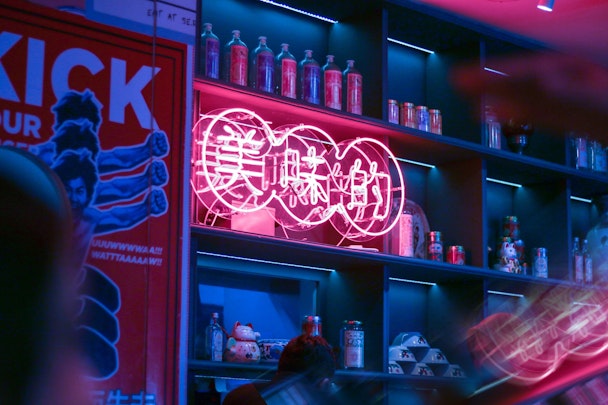RFID tags and AR: can creative technology breathe life back into retail?
Can creativity save brick-and-mortar retail from the brink? Maddie McGovern of Connective3 thinks so, thanks to RFID tags and a raft of augmented reality integrations from the likes of Snapchat.

How are brands using creative technology to level up brick-and-mortar store experience? / Sarah Richer
Through retail store design, a brand can reflect its personality and values, distinguish itself from competitors, and transform how customers interact with it.
Despite coming out of the pandemic and into a world where e-commerce is taking over, physical stores continue to be favored by many. Retail remains an important touchpoint for brands and consumers as the in-person shopping experience allows customers to interact with diverse products.
Advertisement
What could the retail space of the future look like?
Technological advancements have allowed customers to immerse themselves in a contemporary and innovative environment where they can check out effortlessly, minimizing the customer journey time.
Advances in technology have raised the bar for brands looking to innovate how they attract consumers to shop in-store again and offer a more unique and immersive shopping experience. The concept has been dubbed ‘phygital’.
RFID tags
There’s nothing worse than finding products we love, only to turn them down due to a long queue at the checkout. Using radio frequency identification (RFID) labels, L’Oréal has been trialing this easy checkout feature in a recent pop-up shop in Germany. Customers put their shopping bags into a scanning unit that uses RFID labels to scan their purchases. The purchase decision-time can be reduced due to a pay-free checkout, creating a seamless checkout experience.
Armani and Decathlon are implementing a similar hassle-free concept. This new purchasing method is expected to attract a greater number of customers in-store.
RFID tags create a fast and convenient purchasing experience, like e-commerce does. Customers will be able to save time and will avoid the stress of waiting in queues which can factor largely into purchasing decisions.
Advertisement
AR mirrors
Augmented reality (AR) company Zero 10 created digital try-on experiences for Coach and Tommy Jeans, featuring a digital mirror for consumers to virtually try on and style looks in-store without having to physically wear the clothes. The AR technology used 3D body tracking and cloth simulation to make the garments look realistic.
Another brand using technology to revolutionize its retail spaces is Nike. Partnering with Snapchat, the two brands are trialing AR mirrors in Nike US stores. Snapchat has gained popularity for its digital AR filters, and it is now elevating the game by generating virtual fashion looks that can be reflected on mirrors using AR in physical retail stores.
These filters allow users to try on products and can unlock exclusive discounts. This feature aims to encourage user-generated content as consumers use social media to promote the brand through tagging and uploading content.
Suggested newsletters for you
AR window displays
Retailer JD Sports created an immersive installation using AR to transform the front of their Oxford Street store into an arcade machine game. Again collaborating with Snapchat, this Gen Z-targeted design features a QR code whereby customers scan the code via Snapchat and a claw machine arcade game appears, allowing the user to interact with the brand with the chance of winning a prize.
This has allowed JD to attract their target audience of younger consumers to the store while generating a buzz on social media, with influencers and athletes partaking in the challenge which will widen audience reach.
Window displays are one of the most important elements of retail design; often, the first touchpoint between a brand and its target market. They capture the attention of shoppers and draw them into the store. With technology continually advancing, the design of window displays will have no limits when it comes to creativity: becoming more immersive and interactive, featuring various colors and themes to effectively communicate the brand’s message. Going forward, these displays will not only be used to attract customers; they may also serve as a promotional tool, generating mass media attention through social media channels.
Store design: Gentle Monster
South-Korean eyewear brand Gentle Monster is leading the industry when it comes to designing innovative retail spaces. Each store showcases a unique theme that creates a remarkable and unforgettable customer experience. By collaborating with artists and designers, Gentle Monster is able to create eye-catching store designs.
This creates a media buzz, especially on platforms like TikTok and Instagram, and can broaden its reach through word-of-mouth recommendations. Thus, Gentle Monster has been able to establish a better brand perception than competitors, increasing the likelihood of customer loyalty.
Using technology to enhance the shopping experience
The overall visual design of a retail space is crucial. Rather than focusing solely on one specific element (like window displays and AR mirrors), brands must create an atmosphere that will constantly engage the consumer throughout their customer journey. Using design and technology, brands can enhance the perceived desirability of items displayed in-store. This may result in the customer becoming more excited and engaged in the brand’s phygital presence.
Recent technological developments are having a significant impact on retail design, shaping how brands interact with their customers and allowing brands to produce immersive, seamless, and unforgettable shopping experiences. More brands are looking at how they can differentiate from their competitors and attract customers to shop in-store.
Content by The Drum Network member:

connective3
We create market leaders. We do this through the application of digital marketing strategy, adopting SEO, Content Strategy, Digital PR, PPC, Display, Social Media...
Find out more
